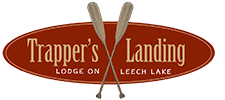Paging Dr. Doolittle…
There are so many reasons to enjoy a north woods vacation – from the outdoor activities to stunning scenery and the lack of rings, beeps and buzzes that have become the soundtrack to our busy lives. At Trapper’s Landing Lodge you’ll enjoy a little peace & quiet in your accommodations – but be prepared for a whole new soundtrack when you step out for some outdoor adventure.
The Leech Lake Area is home to 80 different mammals, a few dozen species of amphibians and reptiles and more than 400 varieties of birds. You may want to pack your field guide and practice your animal calls before you arrive!
Some that may cross your path:
Deer
There are an estimated 1.5 million deer in Minnesota, and northern Cass County may be one of the best wild-venison hunting grounds in the continental United States. It is almost impossible for you to go on a walk in the woods, or drive down a country road here in this area, and not see a couple deer. The largest member of the deer family is the moose, and there are estimated to be up to 7000 of these 1000 pound, elusive animals in northern Minnesota. A moose will smell you long before it sees you, and will do it’s best to avoid you.
Black Bears
Hunters come from as far as Michigan to hunt black bears in Minnesota. It is estimated that there are between 20,000 and 30,000 black bears in the north woods of Minnesota, and about 3000 are harvested every year. Black bears in the wild are actually much smaller than you’d think, weighing only between 100-300 pounds. (I say, only; as if a 200 lb wild animal with 3-inch claws shouldn’t be intimidating.) If you come across a black bear, it will likely run from you, unless it is busy eating honey from a bee hive, in which case, it will ignore you and continue eating.
Wolf
The wolf has been protected by the Endangered Species Act since 1974 and before that, Minnesota was the only state in the lower 48 states that had not exterminated its wolf population. There are about 3000 wolves in northern Minnesota today. The most common cause of death of wolves in Minnesota is by other wolves: they fight over territory. The gray wolf has a sense of smell 100 times stronger than humans. Gray wolves run in packs of six to 12 animals, which makes it much easier to kill deer or moose. They can run up to 40 miles without resting.
Lynx and Bobcat
Lynx and bobcat are both big cats, but the bobcat is very common in this area, while the lynx’s territory is more in far northern Minnesota. You can tell the difference between a bobcat and a lynx, as a lynx will have a white underbelly and a goatee. If you’re walking along in the forest in these parts, and you come across a large uprooted tree or hollowed out log, chances are, someone of the bear, wolf, or cat family has lined the area with moss and leaves, and has made a den/home for themselves there. Don’t go poking your nose around such dwellings, especially in May or June when mothers may be on high alert to protect their young from the likes of you.
Porcupines
Like pigs, porcupines will eat almost anything, especially things that are salty. A porcupine’s natural diet is pine tree bark, but it won’t hesitate to eat your canoe paddles or your ax handle. Porcupines are a common site in this area, even close to town.
Beaver
The largest rodent in North America, the beaver, which can weigh up to 90 lb, is found everywhere in Minnesota. In the 200 acre DNR Wildlife Management Area about two miles from Trappers, you may come across whole beaver colonies, with hundreds of felled trees surrounding dirt mounds in the midst of a swamp. If you’re near a lake and you hear a loud slapping sound, it’s likely that sound was made by a beaver smacking its large flat tail against the water. If you’re in the lake, look around to make sure you’re not too close to a nervous beaver, as that’s the sound they make when they get irritated by human proximity.
The Common Loon
The Minnesota state bird is the Common Loon. Not the Exotic or the Uncommon Loon, mind you, just the Common Loon, of which there are 12,000 pairs in Minnesota. The thing about the loon that makes it stand out among birds is its distinctive loon caw, or call sound it makes. The thing about loons in northern Minnesota is that it’s quiet enough and there’s enough of them, that hearing the hypnotic and lyrical call of a loon echo over the waters of a placid lake is something you can absolutely expect to experience if you spend more than 10 minutes in the Leech Lake area in the summer months.
Horned Owl
Another large bird common in the Leech Lake area is the great horned owl. Owls are capable of catching all manner of small animals, including domestic pets, so you may want to refrain from letting your small dog or cat wander about alone at night, when the owls are out hunting for their next meal.
Bald Eagles
There are 700 + pairs of bald eagles in Minnesota, and eagle sightings in the Leech Lake area are very common. Most locals can point you to a local spot or road from which you can view an eagle’s nest with an eagle perched on a branch next to it.
